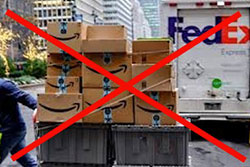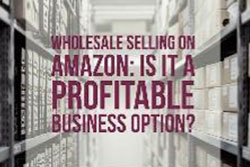Protecting Price and the Channel in an Online Marketplace World (Amazon)
 Amazon Business is talked about regularly within distribution industries in general and especially in the MRO space. Barely a meeting goes by with a manufacturer where the topic of “what should we do regarding Amazon Business” is not asked as is the question of “what are distributors doing online (and to combat Amazon)?” And then the discussion evolves to internal conversations the manufacturer has had, their challenges (and in some cases, successes).
Amazon Business is talked about regularly within distribution industries in general and especially in the MRO space. Barely a meeting goes by with a manufacturer where the topic of “what should we do regarding Amazon Business” is not asked as is the question of “what are distributors doing online (and to combat Amazon)?” And then the discussion evolves to internal conversations the manufacturer has had, their challenges (and in some cases, successes).
Amazon is a threat but can also represent an opportunity. To distributors it can represent lost business. We know some that have embraced and are selling on it. It also represents an opportunity to consider why customers may gravitate to it and examine oneself. To reps it can represent a loss of commission dollars. And many manufacturers are becoming channel agnostic, throwing up their hands and saying “whatever way / wherever the customer wants to buy, I want to be there.”
Hence channel conflict.
At the recent B2B Next Conference (which you should put on your calendar for early next October to expand your knowledgebase on eCommerce), one of the sessions was conducted by James Thomson who is a partner in Buy Box Experts, a managed account services agency focused on Amazon. Here he shares some thoughts on how manufacturers can help control their online marketplace channel:
What Does Effective Channel Control Look Like in An Online Marketplace?
As online marketplaces continue to welcome resellers onto their open market platforms, brand companies have struggled to keep up with the price erosion that typically accompany increased levels of competition across sellers. On the AmazonBusiness.com channel, we have seen products being simultaneously offered by many dozen sellers, all at the same time on the same product listings. These sellers try to outmaneuver one another in order to win the “buy box”. Such competition commonly produces the situation where the online marketplace price is noticeably lower than the branded product’s price in all other online and offline channels. This creates frustration for authorized resellers and distributors that are subjected to MAP or MSRP policies, yet can’t effectively compete for customers when those same customers are able to get the same products for less online.
If a brand is serious about eliminating these cross-channel price gaps, the brand will need to develop and implement a permanent distribution control strategy. With Amazon having a clear policy that it views distribution control as the sole responsibility of the brand – not somehow Amazon’s role – the brand will have to roll out these distribution controls itself. In pursuit of the goal of consistent cross-channel pricing, many a now-proactive brand has taken the approach of trying to remove all unauthorized sellers. With an additional unauthorized seller able to start offering most any product anytime the seller finds an inventory source, the need for a never-ending “whack-a-mole” effort can be frustrating and very costly for the brand.
Today, Amazon uses an algorithm to determine which eligible seller will win the “buy box” on a product listing page. With the “buy box”, the seller’s offer for an item is pre-selected as the default product to be added to the customer’s shopping cart when the customer clicks the “Add to Cart” button. This buy box algorithm considers a number of factors, including:
- Is the seller’s offer Prime-eligible?
- Is the seller’s price close to or at the lowest total landed price among all sellers that are eligible to win the buy box on this item?
While there are other less important considerations that play into the buy box algorithm, these two factors are the most significant, and help us to segment all sellers on a product listing into which are most likely to cause the brand meaningful problems with price erosion off the brand’s desired selling price. And so, the third factor to consider is:
- Is the seller’s price below the brand’s desired selling price?
Today there are literally dozens of software providers that offer brands the opportunity to monitor sellers to see if they are abiding by MAP policies. For brands that are faced with a long list of unauthorized sellers who have no interest or responsibility in abiding by a MAP policy, these types of monitoring tools may help identify the price points that each seller is charging, but the tools don’t answer the key questions of:
- Which resellers selling below MAP were responsible for the largest proportion of recent sales of your product?
- Who were those sellers? Can you actually identify them for the purpose of communicating with them?
Most policing tools will answer the question of which sellers are selling below MAP. Some policing tools will provide additional services to help identify these sellers. While identifying unauthorized sellers is often a rather challenging process, the more effective way of regulating your distribution control is to identify which sellers were responsible for the largest proportion of sub-MAP priced sales. For if a brand is able to track and remove those volume sellers, the problem of sub-MAP priced sales is greatly reduced.
Tools like Triguardian can do volume tracking to support the total sales volume by seller on individual product listings. And while there may still be unauthorized sellers on the channel, the much larger problem of cross-channel price discrepancies is eliminated. It is our experience that most of the incentive to sell as an unauthorized seller exists because the seller is willing and able to sell slightly below the prices of all MAP-compliant sellers. So, if all sellers offering products below MAP prices have been removed (and aggressive, timely on-going channel management makes the brand less interesting to grey market sellers), very little incentive remains for unauthorized sellers to continue to pursue these products as a profit opportunity.
Here is an example, using a top-selling watch on Amazon (a consumer product is used as an example to eliminate any supplier favoritism.)
The item’s list price is $60. Let’s suppose Swatch has a MAP policy that indicates it does not want anyone selling this watch below $60. Today, the buy box winning price is $43.94, well below that $60 desired price point. With seven sellers in total offering the product right now, only two have prime-eligible offers, and only three are selling below the $60 price point.
For the purpose of this discussion, let’s say all of these sellers are not authorized to sell on Amazon. We would argue that initially Swatch should aim to remove the first two sellers, as their sub-$60 Prime-eligible offers are almost certainly generating the lion’s share of the total sales. Swatch would also likely want to remove the third seller, priced at $44.56 (below the $60 list price). With the four remaining sellers all priced above $60, there is no MAP policy violation in place. However, there is also no Prime-eligible offer remaining, causing this listing to score much lower in organic search results on Amazon. And so the task of distribution control would shift to the next stage of developing a position of Swatch having an authorized seller in place with a Prime-eligible offer at or above the desired MAP price.
Rather than focus on removing all of the sellers from the listing, we encourage brands to focus instead on removing those unauthorized sellers that are driving most of the sales volume at sub-MAP prices. This streamlined approach should reduce the level of investment and number of brand executive headaches required to develop a cleaner online marketplace channel distribution strategy.
James Thomson is a Partner with Buy Box Experts, a consulting firm helping brands with their Amazon channel strategy. He is also the former head of Amazon Services, the sales team at Amazon responsible for recruiting 99% of all marketplace sellers. James presented at the recent B2BNext conference
Amazon isn’t going away. Reportedly it is now a $10 billion MRO “supplier”. Perhaps $500 million in electrical? To some / many types of end-users. Worst case it’s a search engine and pricing service. How you compete with them and use them as source of inspiration … a model you need to compete against should be part of your strategic and marketing plans.
How is Amazon impacting your business? Manufacturers, how are you proactively managing your Amazon marketplace experience?























